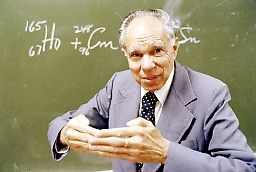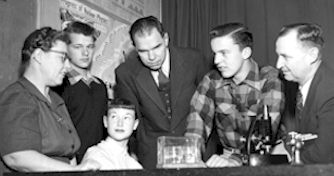"Glenn Seaborg had a generous and youthful spirit
and he genuinely welcomed the many people who met him. He always had time for students and
teachers who visited Berkeley Lab, sharing part of his life and experiences with them in a
way that made each person somehow feel connected in a small way to Glenn's great
adventure."
-- Rollie Otto, Center for Science and Engineering Education
In March of 1994, Glenn Seaborg stepped off a plane at the
Oakland airport, having just returned from a meeting in San Diego of the American Chemical
Society in which element 106 had been named "seaborgium" in his honor. There to
greet him at the gate was a large and boisterous group of cheering Bay Area high school
students.
For all his unparalleled success as a scientist, Glenn Seaborg never forgot what he saw
to be his equal obligations as a teacher. Well past the time when his fame could have
reserved for himself elite classes of cream-of-the-crop grad students, he taught freshman
chemistry. Long after an appointment with Seaborg should have been more difficult to
obtain than tickets to a Rolling Stones concert, students remained able to meet with
Seaborg in his office.
"The education of young people in science is at least as important, maybe more so,
than the research itself," he once told the New York Times.

SEABORG HAD A PASSION FOR TEACHING AND WAS REVERED BY GENERATIONS OF
STUDENTS |
Seaborg backed his words with deeds. In the summer of 1958, when Clark
Kerr became the president of the University of California system, he nominated Seaborg to
succeed him as chancellor for UC Berkeley.
"He was the best balanced, most distinguished faculty member at the most balanced
distinguished university in the country," said Kerr.
Concerns immediately arose amongst the Cal faculty that Seaborg would focus on the
sciences and ignore the other disciplines. In his first speech as Chancellor, Seaborg
sought to reassure them that he revered the unity of all intelligence.
"There is mathematics in music, a kinship of science and poetry in the description
of nature, and exquisite form in a molecule," he said. "All literate men are
sustained by the philosopher, the historian, the political analyst, the economist, the
scientist, the poet, the artisan, and the musician."
During his chancellorship, which was foreshortened by President Kennedy's plea that he
chair the newly created Atomic Energy Commission, Seaborg established a blueprint for the
physical expansion of the Berkeley campus that still guides its growth. He also
spearheaded the College of Environmental Design, the Space Sciences Laboratory, the Earl
Warren Legal Center, the Laboratory of Chemical Biodynamics, and the Humanities Institute.
It was also as Chancellor that Seaborg proposed to the UC Regents the creation of a unique
science museum, in his own words, "a public science, curriculum development, and
educational research center," as a tribute to Ernest O. Lawrence who had just died. A
primary function of this center would be to develop curriculum for science and mathematics
education. Backed by Seaborg's considerable powers of persuasion, the museum opened ten
years later as the Lawrence Hall of Science.
Seaborg was an outspoken member of President Reagan's National Commission on Excellence
in Education. This commission produced the landmark 1983 report, "A Nation at Risk:
The Imperative for Educational Reform," which exposed a crisis in the country's
mathematics and science education programs.
He was a primary mover behind the Chemical Education Material (CHEM) Study, which,
among other objectives, sought to "diminish the gap between scientists and teachers
in the understanding of science," and later in the "Great Explorations in Math
and Science (GEMS)" program, a leading Internet resource for science teachers.
Seaborg also chaired the board of Science Service which publishes Science News and
conducts a yearly national Science Talent Search in which the winners of the top 40 high
school science fairs around the country gather in Washington to compete for $100,000 in
scholarships. Seaborg always helped judge the fair and would interview each of the 40
candidates himself.
His tireless effort as a national advocate for science education was honored in 1987 by
the establishment at the University of Northern Michigan of the Glenn T. Seaborg Center
for Teaching Science and Mathematics. Last year, a generous endowment to UC Berkeley
resulted in the creation of he Glenn T. Seaborg Chair in Physical Chemistry. At last
count, Seaborg had guided the graduate studies of more than 65 successful Ph.D.
candidates.
Said Alexis Bell, Dean of the College of Chemistry at UC Berkeley, "As an
educator, Glenn Seaborg inspired thousands of students to become interested in chemistry
and its applications, and as a public speaker he helped develop an awareness of the impact
of science on daily life and the importance of non-proliferation of nuclear weapons. He
will be remembered as a brilliant scientist, an inspiring teacher, a devoted public
servant, and lastly, as a kind, gentle, and unassuming person."
Most recently, Seaborg chaired the science committee of the California Academic
Standards Commission, a statewide effort to set science standards for the state's 5.7
million public school students. Appointed by then-Governor Pete Wilson, Seaborg fought
with customary determination and grit to make California's standards a model for what
science education in the rest of the nation should be.
"His intellect as well as his personal integrity would not let him accept anything
less than the best for our children," Wilson said.
Not everyone agreed with Seaborg's old-school approach to teaching biology, chemistry,
and physics separately, starting as early as possible, and he did not win all the battles
but his influence in the Commission's final report, like his influence throughout the
scientific and science education communities will be strongly felt for many years to come.
Further Information about Glenn Seaborg:
 SEABORG
(AT CENTER) JUDGING A SCIENCE FAIR IN BERKELEY IN 1954
|
|


